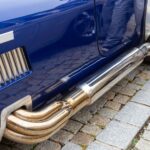Why Understanding Automotive Parts Matters
Whether you’re a car enthusiast, a DIY mechanic, or someone who just wants to keep their vehicle in top shape, understanding automotive parts is crucial. Why? Because every part of your vehicle plays a role in ensuring safety, performance, and longevity. From engines to brake pads, knowing what goes into your car can save you money, improve efficiency, and help you make informed decisions. So, let’s dive into the nitty-gritty of automotive parts—no mechanic jargon, just straight-up, easy-to-digest info.
Major Categories of Automotive Parts
Your vehicle comprises a complex system of components that work together seamlessly. Below are the key categories of automotive parts you should know:
1. Engine Components
The engine is the heart of any vehicle. It converts fuel into power that moves your car. Key parts include:
- Cylinder Block: The foundation of the engine where combustion occurs.
- Pistons: Move up and down to generate power.
- Crankshaft: Converts piston motion into rotational force.
- Camshaft: Controls the opening and closing of valves.
- Spark Plugs: Ignite the fuel-air mixture.
2. Suspension System
The suspension system ensures a smooth and stable ride. It connects the wheels to the vehicle frame and absorbs road shock. Key parts include:
- Shocks/Struts: Absorb bumps and vibrations.
- Control Arms: Maintain wheel alignment.
- Springs: Support the vehicle’s weight.
- Ball Joints: Allow pivoting for steering and suspension.
3. Braking System
Safety starts with brakes. A vehicle’s braking system allows you to stop or slow down effectively. Key parts include:
- Brake Pads: Provide friction to stop the wheels.
- Brake Discs/Rotors: Contact the pads to slow the vehicle.
- Brake Calipers: Apply pressure on the brake pads.
- Brake Fluid: Transfers force to the brakes.
4. Transmission System
The transmission transfers power from the engine to the wheels. Without it, your car wouldn’t move. Key parts include:
- Gearbox: Houses gears to adjust speed and torque.
- Clutch (Manual): Engages or disengages the transmission.
- Torque Converter (Automatic): Transfers power fluidly.
- Drive Shafts: Deliver power to the wheels.
5. Electrical System
Modern cars rely heavily on their electrical systems for performance and comfort. Key components include:
- Battery: Powers the electrical system.
- Alternator: Recharges the battery.
- Starter Motor: Starts the engine.
- Wiring Harness: Connects electrical components.
6. Exhaust System
The exhaust system removes harmful gases produced by the engine and reduces noise. Key parts include:
- Muffler: Reduces engine noise.
- Catalytic Converter: Reduces emissions.
- Exhaust Manifold: Collects engine gases.
- Tailpipe: Releases gases into the air.
Why Quality Automotive Parts Matter
Not all automotive parts are created equal. Choosing high-quality components can make a world of difference for your vehicle. Here’s why:
- Improved Performance: Top-notch parts ensure your car runs efficiently.
- Enhanced Safety: Reliable brakes, tires, and lights keep you safe on the road.
- Cost Savings: Durable parts last longer, reducing repair costs.
- Better Fuel Efficiency: Quality engine and transmission components optimize fuel use.
Pro Tip: Always purchase automotive parts from trusted suppliers or manufacturers.
How to Choose the Right Automotive Parts
Picking the right parts can feel overwhelming, but here are some foolproof tips:
- Know Your Vehicle’s Make and Model Every car is unique. Check your vehicle manual for part specifications.
- Choose OEM vs. Aftermarket Parts
- OEM (Original Equipment Manufacturer): Made by your car’s manufacturer. More reliable but pricier.
- Aftermarket Parts: Often cheaper but may vary in quality.
- Verify Compatibility Ensure the parts fit perfectly with your vehicle’s existing system.
- Check Reviews and Ratings Look for customer feedback to gauge quality and reliability.
- Compare Warranties Good-quality parts often come with a warranty. It’s worth paying extra for that peace of mind.
FAQs About Automotive Parts
- What are OEM automotive parts? OEM parts are produced by the vehicle’s original manufacturer. They’re designed to fit and function like the original components.
- Are aftermarket parts reliable? Aftermarket parts can be reliable, but their quality varies. Always research brands and read reviews before purchasing.
- How often should I replace automotive parts? It depends on the part. For instance:
- Brake pads: Every 20,000 to 50,000 miles.
- Tires: Every 25,000 to 50,000 miles.
- Battery: Every 3-5 years.
- Can I replace automotive parts myself? Yes, if you have the right tools, knowledge, and a good guide. However, some parts (like transmissions) are best left to professionals.
- Where can I buy quality automotive parts? You can buy parts from authorized dealerships, online stores, or trusted local auto parts shops.
Conclusion: Keep Your Vehicle in Top Shape
Understanding automotive parts isn’t just for mechanics or car enthusiasts—it’s for anyone who owns a vehicle. By knowing the key components, choosing quality parts, and staying on top of maintenance, you’re not only extending your car’s lifespan but also ensuring your safety and saving money in the long run. So, whether you’re shopping for brake pads or upgrading your suspension system, make informed choices. Your car (and wallet) will thank you.
Authoritative Links for Further Reading
- National Highway Traffic Safety Administration: https://www.nhtsa.gov
- Car Care Council: https://www.carcare.org
- AutoZone Learning Center: https://www.autozone.com
- Edmunds Maintenance Guide: https://www.edmunds.com/maintenance-guide/
- AAA Automotive: https://www.aaa.com/autorepair







